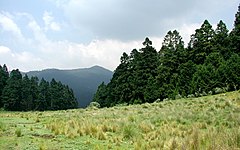Abies religiosa
| Sacred fir | |
|---|---|

| |
| Sacred fir forest in the mountains of Mexico State | |
| Scientific classification | |
| Kingdom: | |
| Division: | |
| Class: | |
| Order: | |
| Family: | |
| Genus: | |
| Species: | A. religiosa
|
| Binomial name | |
| Abies religiosa | |
| Synonyms[3] | |
| |
Abies religiosa, sacred fir or in Nahuatl, oyamel is a fir native to the mountains of central and southern Mexico (Eje Volcánico Transversal, Sierra Madre del Sur) and western Guatemala. It grows at high altitudes of 2,100–4,100 metres (6,900–13,500 ft) in cloud forest with high rainfall and cool, humid summers and dry winters in most of its habitat regime but in the state of Veracruz to the east it grows with precipitation all year long. Regular winter snowfalls occur on the highest populations.
Description
Abies religiosa is a medium-sized to large evergreen coniferous tree growing to 25–50 m (82–164 ft) tall with a trunk diameter of up to 2 metres (6.6 ft). The leaves are needle-like, flattened, 1.5–3.5 cm (0.59–1.38 in) long and 1.5 mm (0.059 in) wide by 0.5 mm (0.020 in) thick, dark green above, and with two blue-white bands of stomata below; the leaf apex is acute. The leaf arrangement is spiral on the shoot, but with each leaf variably twisted at the base so they lie flat to either side of and above the shoot, with none below the shoot. The shoots are reddish-brown, hairless or with scattered pubescence. The cones are 8–16 cm (3.1–6.3 in) long and 4–6 cm (1.6–2.4 in) broad, dark blue-purple before maturity; the scale bracts are purple or greenish, of moderate length, with the tips exposed in the closed cone. The winged seeds are released when the cones disintegrate at maturity about 7–9 months after pollination. Trees from the western end of the range on Nevado de Colima, Jalisco have cones with larger, reflexed bract scales (similar to noble fir cones); these are sometimes treated as a separate species, Abies colimensis.
Cultural significance
Sacred fir is named after the use of cut foliage in religious festivals in Mexico, notably at Christmas. It is also the preferred tree for the monarch butterfly (Danaus plexippus) to reside in colonies during its hibernation in Mexico. The distribution of this tree is narrowing because of deforestation and human impact.
References
- ^ Template:IUCN2013.2
- ^ "Abies religiosa (Kunth) Schltdl. & Cham". Germplasm Resources Information Network. United States Department of Agriculture. 1999-10-12. Retrieved 2009-10-22.
- ^ The Plant List
- Liu, T. S. (11 November 1971). A Monograph of the genus Abies. National Taiwan University.
- IUCN Red List least concern species
- Abies
- Plants described in 1830
- Trees of Durango
- Trees of Guerrero
- Trees of Hidalgo (state)
- Trees of Jalisco
- Flora of the State of Mexico
- Trees of Michoacán
- Flora of Morelos
- Trees of Puebla
- Trees of Veracruz
- Trans-Mexican Volcanic Belt
- Trees of temperate climates
- Least concern plants
- Trees of Guatemala

